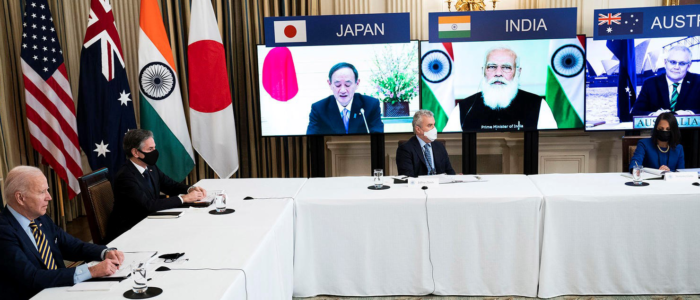The Biden administration put forth its iteration of the Indo-Pacific Strategy, per which the US faces significant challenges in the region due to China’s allegedly growing aggressive stance. The US considers China’s coercive efforts as an attempt to change the current international rules and norms in its favour. The purported Chinese provocations seem to test the US and its allies’ “collective resolve”. As such, Washington intends to counter Beijing by increasing its regional presence and bolstering the capabilities of its regional partners. China, of late, has stepped up what the US and its allies call provocative and unsafe actions, particularly in the South China Sea. Such actions include aggressive interceptions of ships and aeroplanes of the US and its allies, which can lead to loss of life or risk of starting a conflict.
To counter or “control” China’s expansion, the US is focusing on the defence alliances and treaties it already has with nations in the region like South Korea, Japan, Australia, the Philippines, and Thailand. Recently the US, with its QUAD allies, India, Japan, and Australia, launched the Indo-Pacific Partnership for Maritime Domain Awareness (IPMDA), which entails space-based maritime domain awareness and provides near real-time satellite data to the end users. This allows the QUAD allies to know what is going on in the waters of the Indo-Pacific region. Currently, IPMDA is a QUAD-only initiative, but it will be, in the long run, made available to other allies in the region. As smaller nations are given access to it, they will be able to use the rapidly processed data to know what is happening in their waters. These states do not have the capabilities required to fully monitor their waters. This system will allow them to focus only on where a problem may be rather than using resources to first find the problem and then solve it.
Washington intends to counter Beijing by increasing its regional presence and bolstering the capabilities of its regional partners.
Besides, the US is slowly changing its focus with respect to security assistance. With China now being the main concern, there is talk of the US shifting its attention in this realm from the Middle East to the Indo-Pacific. During a conference at the end of July, the US Assistant Secretary of Defence for Indo-Pacific security affairs, Ely Ranter, stated that slowly the focus is shifting to the Indo-Pacific region. Responding to a question about security assistance, he stated that the numbers currently show that the foreign military financing (FMF) for regional partners has grown in some areas, which will be further expanded. The strategy is to give the allies in the region asymmetric advantages in a supposed fight against a larger adversary. The Ukraine conflict has only driven this line of thinking home in the minds of US strategic thinkers. Advantages like up-to-date satellite imagery can make a substantial difference and help make the best use of a smaller military’s limited resources, which is another observation drawn from the Ukraine conflict.
At the same time, the AUKUS (Australia, UK, US) trilateral partnership is looking to help Australia build deterrence by providing it with conventionally armed nuclear submarines while working on other advanced capabilities jointly. The three partners are consulting and then deciding how to provide and help the Royal Australian Navy sustain nuclear submarines. The partnership is currently in its initial stage, but it also shows that US’ European allies, especially the UK, are keen on cooperation in the Indo-Pacific region.
As stated earlier, the primary focus of the US Indo-Pacific strategy is strengthening its cooperation with those allies with which the country has defence treaties or alliances within the region. With Thailand, the US is looking at expanding bilateral training and exercise possibilities. Similarly, the major power is placing more emphasis on its defence cooperation agreement with the Philippines, which currently results in 300 military to military activities a year. Top US officials have repeatedly stated that any attack on the Philippines would invoke mutual defence commitments. Earlier this year, the US and the Philippines conducted the 37th iteration of their bilateral Balikatan exercises, in which 9000 personnel from both states took part. The US is also engaging with other states in the region. It is undertaking bilateral exercises with Indonesia and high-level engagement with Vietnam. Many other countries from the region also participated in the recent iteration of the Rim of the Pacific (RIMPAC) exercise, a biannual exercise by the US Indo-Pacific Command.
Likewise, the US is aiming to build a more capable and dynamic forward presence in the region, which is being fulfilled via the Pacific Defence Initiative (PDI). PDI prioritises China as the main threat to peace and security in the region, and in the Fiscal Year 2023, Congress has approved $6.1 billion in the Department of Defense (DoD) budget. This incorporates investments to enhance US force posture, infrastructure, readiness, and presence in the Indo-Pacific. In the long run, it is hoped by US policymakers that these investments will also help their allies, as many of the upgrades and new developments are at bases located in ally nations like Japan, South Korea and Australia.
The US also sees India as a key partner in the region. As such, it hopes to increase the “Major Defence Partnership and support its role as a net security provider” in the region, as stated in the Indo-Pacific Strategy. Recently, US and Indian forces have also conducted multiple bilateral exercises in the Indian Ocean. The current administration has also stated that they will continue “supporting India’s continued rise and regional leadership,” which they hope will counter China’s influence in the region.
Overall, the US has realised, due to the Ukraine conflict, that if they successfully provide their allies with asymmetric advantages, they will use their limited resources to their best effect against an adversary many times larger.
